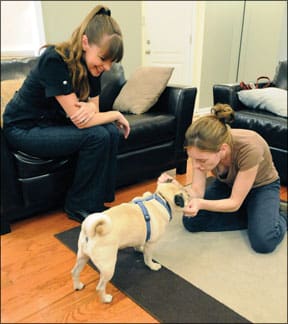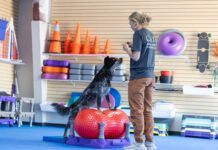Entering its sixth season, the Animal Planet TV channels Its Me or the Dog takes dog trainer Victoria Stilwell into the homes of frustrated couples and families to help them troubleshoot issues with their problem pooches. Broadcast in 21 countries, the show was based for its first four seasons in Stilwells native United Kingdom, while the past two seasons have seen the show move to U.S. soil, taping in Los Angeles and Atlanta.
photo courtesy Victoria stilwell 288
Stilwell is also author of Its Me or the Dog: How to Have the Perfect Pet (Hyperion Books, 2007) and Fat Dog Slim: How to Have a Healthy, Happy Pet (Collins, 2007). Stilwells mission is to bring her positive training message to the masses. We had time to sit down with her in Atlanta, in between West Coast swings, to talk about her work.
Whole Dog Journal: How did you come to positive training?
I remember when I was first starting to learn and I was walking dogs and teaching them to heel. The way that we used to teach them to heel was to give them a leash jerk, and then the dog would stay by your side for a little bit. But then I thought, Wait a second. What does this word heel mean to a dog? It means, I say the word heel, and then it means leash jerk! The dogs not learning to walk close to me because he wants to, hes learning to walk close to me because he fears whats going to happen to him if he doesnt. I have to say this was a long, long, time ago. I thought, This is bizarre, this is stupid; surely theres a smarter way.
I learned from a behaviorist who was very mixed using traditional and positive training and then I met some more positive reinforcement trainers in the U.K. and I said Thats it! Thats it! That feels much more comfortable, that makes sense, to build a relationship thats based on cooperation, not dominance. Much better!
Describe your training philosophy.
I believe the best kind of leaders lead without force. In the beginning when I first started learning, I learned sort of a mixture. I never felt comfortable using that kind of approach (traditional methods); this was about 15 years ago when I first got into training. I realized the dogs actually responded much, much better when you used positive reinforcement. You reward a behavior you like, and theres a chance of that behavior being repeated. Its as simple as that!
I didnt like jerking a dog on a leash, and I didnt like yelling. I used to use quite loud sounds sound aversion that I dont use now. I learned different methods from different people, and took the stuff I liked. The discipline now that I like to use is guidance. Its constructive discipline, not destructive. I would say Im not violently positive [laughs] because I do believe that there has to be discipline; I do believe at certain times you have to say no to your dog. The discipline that I use now is a vocal sound as an interrupter of behavior, a time-out (removal), or ignoring the behavior.
Who are your mentors or from whom do you take inspiration?
Dr. Ian Dunbar. Patricia McConnell big time; I just love her books, shes Gods gift to training. Suzanne Clothier I think shes a real pioneer, shes intense, she has a mind that puts all of our minds to shame. Shes an incredible person. If anybody should pick out the Obama family puppy, she should. Jean Donaldson. Ive learned a lot from her. Ive also got some fabulous trainer friends here [in Atlanta], wonderful people. And thats what I love as well. I would say for any trainers, try and get with other trainers because its so wonderful to be able to talk through ideas.
For example, one dog on my program, a Boxer, who was on the first program we filmed here in the U.S., I had three days with this dog, which was not long enough. He was very dog-aggressive, very insecure, very unconfident. By the end of the program, we could only get him to a certain point, so were still working with him. Unfortunately, after filming, he blew out two knees, so he was in a crate for six months, basically. So were back working with him again now, and my trainer friends, we all do it together. We go and its two hours of absolutely inspiring, stimulating, exciting work; I love it. I love when we train together.
And the trainers I hang out with, we are open to seeing other things. We might not agree with them, but we are open to seeing. There are a couple of incredibly good trainers I know who work with very difficult dogs, and they use remote [collars]. I was open to going and seeing this method. Now, whether you agree with it or disagree with it I dont really like it but Im open to seeing it. And I think thats the mark of a good trainer; you must know what else is out there in order to be able to form your own opinion.
Do you see a general trend toward positive or more traditional (compulsion-based) methods?
In England, theres much more positive reinforcement. There are still some traditional and compulsion trainers there, but I think theyre much further ahead in England when it comes to training dogs. Whereas here in the United States, Im absolutely shocked at the amount of traditional/compulsion trainers still training this way, who truly believe and validate what theyre doing. My dogs well behaved [due to compulsion-based methods]. Im going to get my dog to do what I want it to; Im going to make my dog well behaved.
I see it in trainers who have been training for many, many years who do not want to change their ways, but also I have to say . . . some TV programs that are now very popular have set dog training back 40 years. No TV program is perfect. Surely theres stuff with mine that maybe I would change. For example, we didnt show more process, so it seems like a quick fix.
But, on the whole, the positive reinforcement message is getting out. There are two camps; there is a battle going on and I will fight it. Any person who trains in the dominance style of traditional training does not have my vote. Its the idea that if your animal misbehaves you discipline it, you dominate it, you make it submissive toward you so that it doesnt misbehave anymore. But theres no emphasis on relationship.
Why not use aversives, especially when they work?
They work to a point. Quick fixes very quickly come unstuck, thats my motto. I would rather my dog follows me and does stuff for me because she wants to, rather than because shes made to. And unfortunately, there are people who dont care. As long as their dog behaves, they dont care [what method they use]. But I care and I think that we, who domesticated these animals, wed better do our utmost to make their lives as rewarding as we can because we brought them into our homes. Theyre living, breathing, essential beings, and they need our support to live in our domestic world.
How do you feel about taking on the challenge of re-training the worlds dog owners not to use force and violence?
I feel very honored by the challenge. Im by no means the best trainer in the world, Ive never claimed to be. I just had an idea for a TV program; I wanted to take my positive reinforcement message out to the masses and it worked. I feel very honored, but Im a bit of a fighter. And people who know me know that Im a fighter, and Im going to win this battle.
How do you educate people about positive training? What do they want to hold on to about traditional training?
I tell them, first of all, if you are learning, when you went to school, what kind of schooling would you have preferred to receive? Would you prefer to learn by getting gold stars for working really well, or would you prefer to learn by being punished if you werent? In nursery school, I remember getting a ruler on my hand! I was three years old, and I remember that. And I hated it, and I hated the teachers, and I couldnt wait to leave and I would cry and pretend I was sick to my Mom so I didnt have to go. Then I went to a new school, and it was reward-based, with wonderful teachers, and I wanted to go to school, I wanted to learn, and I learned much more! Thats the kind of education that I wanted to receive. And its your responsibility to give your dog a good canine education.
But lets get down to the very crux of the problem: people dont have time. So if the shock works on their dog, thats bloody well going to do it. They dont have time.
Many people say, Give me something that works quickly. Which is why the CM (Cesar Millan) program . . . its edited beautifully to make it look so wonderful, but its interesting because some of the cases on there that are labeled successes, are so not successful to a trainers eye; were howling at the television. This dog is freaked out, yet its labeled a success, and thats what people are watching, thats what people are thinking. And unfortunately, people do not have time to read, they dont want to be educated, its a fast society; get my dog to behave and thats enough. And thats what were battling.
That begs the question of why, in our time-crunched society, are people getting dogs?
Companionship. [But sometimes] its a pleasure for when they want it, and obviously, a lot of it is a fashion statement. I always say to people when they want to get a dog: What do you think you can offer the dog? If a dog was going to choose to come into your home, what experiences do you think it would have? How do you think its going to feel, living with you? Tell me about you? Do you shout a lot? Do you sleep a lot? Tell me about you. And then see what kind of dog might be able to live with you. And if you think you dont have time, and youve got five kids well, dont do it.
How do you feel about trying to educate people about the science of behavior modification versus what people think of as training making the dog just do something, as quickly as possible?
I ask them, what kind of leader do you want to be? Do you want your dog to look up to you and do things because he wants to, or do things because he fears you? You choose. If you want the former, Ill work with you. If you want the latter, Im not your person and Ill caution you against it. Do you want to have a relationship built on cooperation, or one built on domination? You can go down the other route, its your prerogative, but I feel sorry for your dog. And I feel sorry ultimately for you because I think youre going to encounter a lot of problems with your dog in the future.
Are people able to get their brains around what you are saying?
They really are. I can be pretty blunt, but Im also compassionate.
Those of us who use positive training can get frustrated when we see someone using aversives. How do we convince someone that there is another way?
Inc. 288
If you fight fire with fire, youll get burned. The person will get irritated.
I try to explain, Hey, theres a different way, and its exciting! I was on a beach in Florida, and a guy was walking his Golden Retriever and it was lunging at other dogs, and he would slam it down, put it in an alpha roll and stand over it, then hed get up, walk, and then another dog would go past, and the dog would lunge, and he would slam it on the ground. My husband said to me, Oh no, please, dont go over there.
But its like stopping a raging bull. I said, Im not going to go over there and slam him. Im going to go over, introduce myself, say who I am, and tell him theres a better way. And I worked with him for a half an hour, and we had the dog not lunging at other dogs that were walking past. And the owner said, Oh my gosh! Thats amazing! Its not amazing, but for people who havent seen it before, it is.
What about when people object to training with food?
Oh, Im bribing my dog. No youre not, youre giving incentives! I say, look, you dont have to use food! Find out what your dogs most powerful motivators are: food, toys, play, praise, or something else? Lets find out. Many people think positive reinforcement trainers only use food, but we dont. I reinforce everything all the time, but Ill do it with praise, and the next time with food, then the next time with praise, then Ill pet the dog; I vary it. But I believe that we need to give feedback.Your expectation is there will always continue to be rewards of some sort?
Yes! Mark it, as you like to be marked, Oh, you look nice today, or That was a really good job! Mark it, it makes them feel good. Lets make our dogs feel good about what they are doing!
Ive heard you say that people who train dogs need to love not only dogs, but people.
Absolutely, and I do love people, and I think that is the most important thing. Because if you do not have the ability to change the persons mind, to encourage the person to change, to encourage the person to train her dog, and to carry on training, youve failed. Show them that they can get results the other way and then people have an Oh my gosh moment: I couldnt believe that my dog would do this! and the dogs looking much happier. And the relationship begins to grow.
So do you come at it with the approach of dealing with the people, first?You bet. Always. It surprises me how many trainers out there are not people people. I dont think you can be a good trainer without being a people person. What Ive found thats so important when I go into a home, I get the person to talk to me. I dont just go in even though it seems that way in the program. We have a day, and Im looking, Im observing all day and then I get the person to talk. Im listening, listening, listening, and get the real story. You find so many clues from what people have to say. Finally, theyve got someone whos listening to them.
Sometimes people cry, sometimes they get very angry. And then I always tell people, You know what? You can trust me. Ive got your back. Ive got your dogs back. Even though this is a TV program, Im going to do everything in my power to make sure youre in a better place when I leave. And that immediately puts people at ease. Theyre pretty shocked that, after the program, Youre going to keep in contact with me? Yeah, youre a client! We dont just go away.
What are the most common mistakes you see people making when they do use positive training techniques?
You can teach obedience training very quickly with positive training. But when youre trying to change a behavior, thats what people dont understand; they want quick results. Traditional training methods suppress the behavior; thats what theyre designed to do. They dont change the way the dog feels. Whereas positive training changes the way a dog feels inside. For anybody, human or dog, making that emotional change can sometimes take time.
I put it in human terms. I say, look, if somebody is suffering from anxiety, and theyre going to a psychiatrist, do they go for one session? No they dont, they go for many. And even at the end of that, they might not be 100 percent. But theyll have coping mechanisms, and they begin to feel different. And some will do a complete turnaround, others might just do three-quarters. Im not equating dogs to humans, obviously, but you sometimes have to use a human example, otherwise sometimes people dont get it!
But when I explain that a dogs brain is similarly wired to a humans in terms of emotion, they go, Oh, yeah, it does take a long time to change emotion in humans, so I guess it can take a long time to change emotion in dogs if the dogs brain is like a humans. Thats fascinating, I didnt know that! Understanding that positive training takes time, but ultimately, youre going to have a dog who feels better! Your dog is happier, and your life is made easier. Its a win-win situation for everybody.
What do you think about the behavior problems we see today? Do you think we have so many more canine behavior problems than in the old days?
I think there have always been a lot of behavior problems, but dogs had been working. That was what a dog was for. And now, dogs are living with the pressures of our weird domestic society. They cant pee and poop in the house; they have to do it outside. And they cant bark, and they cant tell another dog to go away, cause theyll get told not to, even though theyre scared. And theyre having to meet other dogs every day, even though they might not be sociable, and then youve got kids and other people . . . its a lot of pressure! No wonder!
Plus, the ridiculous industry of puppy mills, which is just breeding dogs with no attention to temperament. Its a money machine, so were getting messed-up dogs out there with anxieties and medical issues.
Thats where America is so backward. Im sorry! Get with the program! Regulate these puppy mills, shut them down! If you want a puppy industry, regulate it. I dont believe there should be an industry at all, but if theres going to be one, get with the program, get smart. Same in Britain. Even though theyre not allowed to sell pets in pet stores anymore, you can still get puppies online.
What is the most common behavior problem you encounter today?
A lot more anxieties, a lot more separation anxiety. A sense of abandonment. There are a lot of reactive dogs out there. Temperament-wise, we are seeing a lot more dogs with aggression issues because of the way theyre bred. Thats very worrying. Also, were seeing a lot of aggressive dogs from people who have trained in the traditional style. I dont care what you label aggression protection, whatever I believe aggression comes from an underlying insecurity. A confident dog doesnt feel the need to aggress. It comes from an underlying insecurity.
What are some of the most rewarding or difficult cases youve worked on?
Junie B, a very aggressive little Poodle [U.S. season one]. Junie B hated boys, hated men, loved the girls. Now Junie B hangs out with the little boy in the family and his friends, shes letting the husband take her for walks, shell voluntarily jump up into his lap and go to sleep. Its so beautiful.
Also, two pit bulls I worked with, belonging to a guy named Victor [U.S. season two]. One was dog-aggressive. Victor was so overwhelmed, very emotional, and now the change has been incredible. Both of these were people who really worked. They were passionate about their dogs and worked at it. And that feels so good.
Both families, they didnt relish being on TV. Its funny, because a lot of people say, Oh its because they want to be on TV, but a lot of the families dont. They see it as an opportunity. Were going to air our dirty linen and were going to do it because our dogs are worth it.
We had a neglected pit bull-mix, out of control. On the day of observation, I went in there, and I said I dont believe you should have this dog, you should not keep this dog. This dog is not going to be successful in your home. Lets work to get it to a point where hes adoptable and re-home him. For those people, I knew that I had to get the dog out of there. Whether its a TV program or not, I will not allow a dog to continue in an abusive or a neglectful situation. I think sometimes that there are people who get dogs, and its the wrong thing. As long as they can work hard to re-home, think whats better for the dog.
You speak a lot about rescue; why is this important to you?
I started in rescue; I was a volunteer, Ive volunteered all my life in rescue. I remember when I was a volunteer dog walker at a shelter however many years ago that was, Im getting so old! There was this little black dog, terrified of people, and then this child came along and she started petting this dog. And I was saying Stop! and this dog just loved her. And I went, Oh my gosh, youre terrified of adults, but not children! That was when I realized that I loved this. So Ive done rescue now for 15-16 years. I liked to see how dogs developed and how from a horrendous abandonment situation they would then go to a new home.
I wish we didnt have to have rescue shelters but we always will. Helping is something valuable you can do for your community. You can do so many things you can donate things, you can donate money, or you can bring in blankets, toys. You can take dogs for a walk, or you can just go and hang out with a dog. We get our volunteers at PAWS Atlanta (a private shelter in Atlanta) to take the dogs out and just hang out. The dogs learn to be calm when they need to. I do rescue work when I can, which is not that much these days, at PAWS Atlanta, and I work with three other volunteer trainers there.
In addition to rescue, Im passionate about getting puppy mills closed down or regulated. Im going to be marching in Pennsylvania demonstrating against the puppy mills up there for Puppy Mill Awareness Day in September.
Im also setting up a foundation, which Im very excited about. Its Victoria Stilwells Think Dog Foundation. Were going to support smaller shelters, and also help children with disabilities with assistance dogs. The foundation is going to help give out money to those various groups, and we expect to launch it in early summer 2009.
Lisa Rodier lives in Alpharetta, Georgia, with her husband and two Bouviers.






